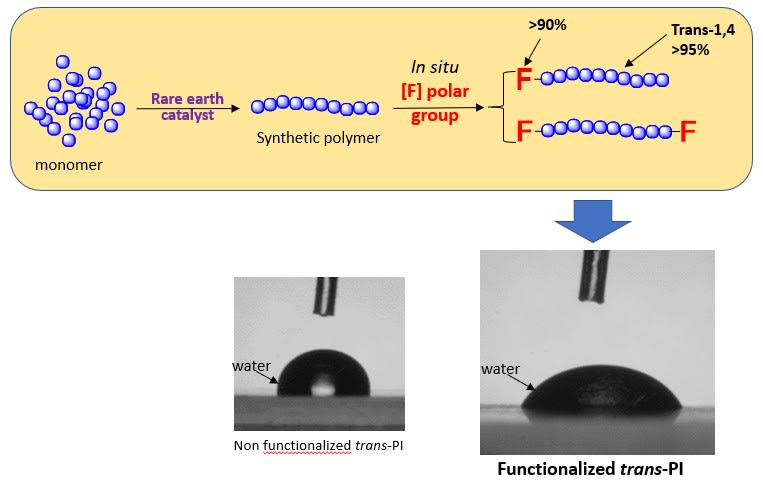New family of functionalized stereoregular polydienes
We have developed a new family of synthetic end-functionalized trans-1,4 regular polydienes. They can be used as super surfactant additives or as reactive building blocks for new innovative polymer families.

Issue
Obtaining elastomers exhibiting a mixed hydrophobic/hydrophilic nature is an essential challenge in the chemical and polymer industry.
Today, there is no effective method for accessing end-functionalized polydienes having rigorously controlled trans-1,4 stereoregularity with high formation rate and functionalization rate. In particular, there is a need to be able to access such polymers with a limited number of reaction steps in the interest of being competitive with respect to production on an industrial scale.
Today, there is no effective method for accessing end-functionalized polydienes having rigorously controlled trans-1,4 stereoregularity with high formation rate and functionalization rate. In particular, there is a need to be able to access such polymers with a limited number of reaction steps in the interest of being competitive with respect to production on an industrial scale.
Solution
Thanks to an unprecedented synthesis strategy patented in Europe and the USA, we have been able to prepare new polydiene elastomers which present a terminal polar function, in an identical manner to a surfactant.
These trans-1,4 stereoregular polydienes with very high formation rate (>95%) and high functionalization rate (>90%) are obtained by coordinative catalytic polymerization of at least one conjugated diene monomer.
Several applications are possible for these polymers:
1) As an additive (1-5%) in formulation, they will help improve the lack of miscibility in a blend of materials of opposite nature (i.e. polar inorganic/organic and non-polar organic materials) to lead to hybrid materials.
2) As a building block ( ̴50%), they will be of use in the preparation of ABA triblock and (ABA)n multiblock copolymers, where A is a classic polymer (for example a biodegradable polyester) chain while B comprises the stereoregular polydiene segment. This will confer new mechanical and physicochemical properties on the final block copolymer.
As regards the synthesis, the one-pot route comprises 3 major steps including polymerization of at least one conjugated diene monomer in the presence of a rare earth catalytic system; preparing the functionalization via chain transfer to an alkali metal reagent; adding the functionalizing agent to obtain the formation of a trans-1,4 stereoregular diene polymer functionalized at at least one of its terminal ends.
These trans-1,4 stereoregular polydienes with very high formation rate (>95%) and high functionalization rate (>90%) are obtained by coordinative catalytic polymerization of at least one conjugated diene monomer.
Several applications are possible for these polymers:
1) As an additive (1-5%) in formulation, they will help improve the lack of miscibility in a blend of materials of opposite nature (i.e. polar inorganic/organic and non-polar organic materials) to lead to hybrid materials.
2) As a building block ( ̴50%), they will be of use in the preparation of ABA triblock and (ABA)n multiblock copolymers, where A is a classic polymer (for example a biodegradable polyester) chain while B comprises the stereoregular polydiene segment. This will confer new mechanical and physicochemical properties on the final block copolymer.
As regards the synthesis, the one-pot route comprises 3 major steps including polymerization of at least one conjugated diene monomer in the presence of a rare earth catalytic system; preparing the functionalization via chain transfer to an alkali metal reagent; adding the functionalizing agent to obtain the formation of a trans-1,4 stereoregular diene polymer functionalized at at least one of its terminal ends.